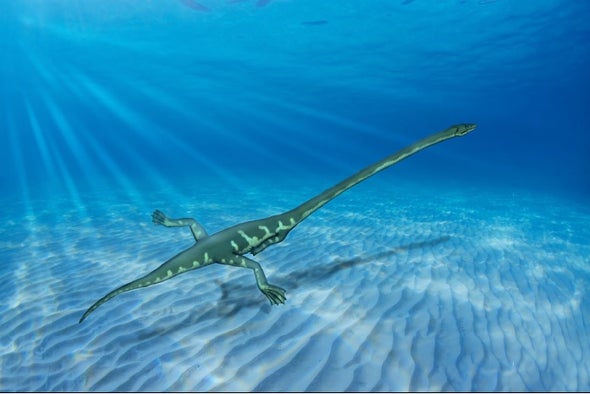Why the Long Neck?
For over a century the natural history of the fossil reptile Tanystropheus has puzzled paleontologists

Tanystropheus
is a Mesozoic favorite. While not even close to being a dinosaur, this
Triassic saurian has nevertheless earned a place next to the terrible
lizards in plenty of books for its unabashed weirdness. A standout among
reptiles of its time, the amphibious creature has long, low body is
capped with an extraordinary neck and tiny head full of pointed teeth.
But how did Tanystropheus make its living? The context of its prehistoric environment hints that Tanystropheus lived along ancient shores. That much experts could agree upon. But the reptile didn’t look like a streamlined swimmer. Maybe, as various artists famously envisioned, Tanystropheus gripped slippery rocks along the shore and dipped its head in the water to snag unsuspecting fish in the shallows. What else could such a ridiculous neck be for?
The wait-and-dip scenario never had direct evidence in support of it, though. It was just difficult to imagine Tanystropheus doing anything else. But now a new analysis by paleontologists Silvio Renesto and Franco Saller has attempted to paint a finer-detailed picture of Tanystropheus lived.
As far as that ludicrous neck goes, Renesto and Saller point out, Tanystropheus didn’t have much flexibility. Previous studies had found that the reptile’s 13 neck vertebrae were relatively rigid, stiff in both horizontal and vertical planes. Whipping its neck after fish wasn’t on this saurian’s agenda. And while found shoreline habitats, Tanystropheus also seemed to lack traits associated with strong swimming skills.
To better understand the enigmatic reptile, then, Renesto and Saller looked to the biomechanics of its trunk, hips, and limbs. Tanystropheus ends up as a mish-mash of traits that would have made it a somewhat awkward reptile. While the arms and legs of the Triassic creature were relatively slender and seem best suited to life on land, the researchers point out, its limbs would have allowed it to row through the water.
The new study places the predatory activities of Tanystropheus more in the waves than at the water’s edge. “Tanystropheus may have had lived in a shore line environment, where the elongate neck, may have been used to catch preys in shallow water by dashing at the prey propelled by hindlimbs,” Renesto and Saller write. And a tiny head on a long neck might have been advantageous in such a scenario, allowing Tanystropheus to surreptitiously get closer to prey with its tiny head than if its potential victims detected the motion of its larger body.
Whatever Tanystropheus was doing, however, it was good at it. Renesto and Saller point out that this reptile was widespread in both time and geography – several Tanystropheus species lived on Earth from ancient Italy to China and North America over the course of tens of millions of years. Strange as they look to us, these were not evolutionary novelties that were destined to fail. They were a hit, which only deepens the mystery of how they lived.
You can read the paper by Renesto and Saller, which includes some lovely illustrations, here.
But how did Tanystropheus make its living? The context of its prehistoric environment hints that Tanystropheus lived along ancient shores. That much experts could agree upon. But the reptile didn’t look like a streamlined swimmer. Maybe, as various artists famously envisioned, Tanystropheus gripped slippery rocks along the shore and dipped its head in the water to snag unsuspecting fish in the shallows. What else could such a ridiculous neck be for?
The wait-and-dip scenario never had direct evidence in support of it, though. It was just difficult to imagine Tanystropheus doing anything else. But now a new analysis by paleontologists Silvio Renesto and Franco Saller has attempted to paint a finer-detailed picture of Tanystropheus lived.
As far as that ludicrous neck goes, Renesto and Saller point out, Tanystropheus didn’t have much flexibility. Previous studies had found that the reptile’s 13 neck vertebrae were relatively rigid, stiff in both horizontal and vertical planes. Whipping its neck after fish wasn’t on this saurian’s agenda. And while found shoreline habitats, Tanystropheus also seemed to lack traits associated with strong swimming skills.
To better understand the enigmatic reptile, then, Renesto and Saller looked to the biomechanics of its trunk, hips, and limbs. Tanystropheus ends up as a mish-mash of traits that would have made it a somewhat awkward reptile. While the arms and legs of the Triassic creature were relatively slender and seem best suited to life on land, the researchers point out, its limbs would have allowed it to row through the water.
The new study places the predatory activities of Tanystropheus more in the waves than at the water’s edge. “Tanystropheus may have had lived in a shore line environment, where the elongate neck, may have been used to catch preys in shallow water by dashing at the prey propelled by hindlimbs,” Renesto and Saller write. And a tiny head on a long neck might have been advantageous in such a scenario, allowing Tanystropheus to surreptitiously get closer to prey with its tiny head than if its potential victims detected the motion of its larger body.
Whatever Tanystropheus was doing, however, it was good at it. Renesto and Saller point out that this reptile was widespread in both time and geography – several Tanystropheus species lived on Earth from ancient Italy to China and North America over the course of tens of millions of years. Strange as they look to us, these were not evolutionary novelties that were destined to fail. They were a hit, which only deepens the mystery of how they lived.
You can read the paper by Renesto and Saller, which includes some lovely illustrations, here.

Nenhum comentário:
Postar um comentário
Observação: somente um membro deste blog pode postar um comentário.